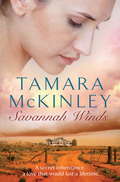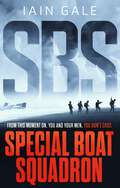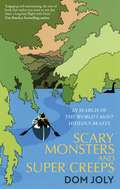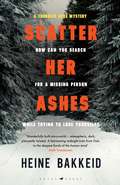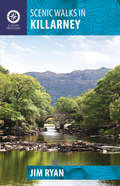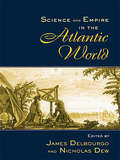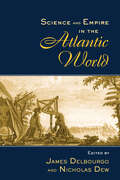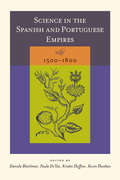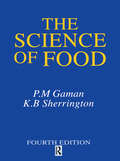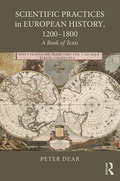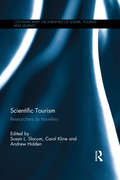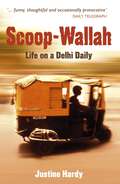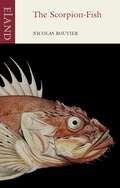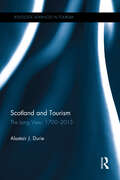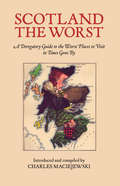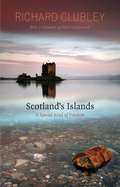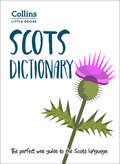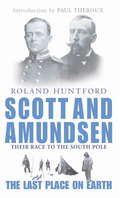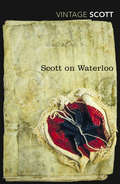- Table View
- List View
Savannah Winds
by Tamara McKinleyWhen Fleur receives word of a surprise inheritance from an aunt she never knew, it couldn't come at a more opportune moment. Her relationship is crumbling, and she's caught in the middle of a serious family rift. Consulting her aunt's long-lost diary, Fleur sets out on a voyage of historical discovery up the coast and through the Gulf Country, to the isolated cattle ranch Savannah Winds. But unbeknownst to Fleur, what she uncovers there could have devastating repercussions for her own life. Set between the 1930s and the modern day, Savannah Winds is an exploration of family ties, bitter rivalry and the strength of enduring love.
SBS: Special Boat Squadron
by Iain GaleA historical adventure chronicling the exploits of the Special Boat Squadron, the seaborne raiders who, by strength and guile, carried out World War Two's most daring covert operations.From this moment on, you and your men, you don't exist. Formed in the darkest hours of the Second World War, as nation after nation fell before the unstoppable Axis advance, the task of the SBS was to strike back at an enemy no army could meet in the field. Trained in sabotage and surveillance, the Special Boat Squadron raided deep behind enemy lines, sowing chaos and capturing much-needed intelligence. Soldiers, adventurers and rogues, their methods were unorthodox, their success rate unprecedented.Operation Anglo, 31 August 1942.Beneath the waves of the Mediterranean, HMS Traveller closes in on the coast of Rhodes. Aboard, eight SBS commandos check their weapons as they prepare to infiltrate and sabotage two Axis bomber fields. Only two of the eight commandos will make it back to alive. Ex-Black Watch Sgt Jim Hunter will be one of the lucky ones, but what he will face next will make Operation Anglo look like a cakewalk.Reviewers on Iain Gale:'A fast fit fighting yarn that transports you to the deadly hillsides of wartime Crete.' Quentin Letts on SBS 'A powerful novel of men at war. A triumph.' Bernard Cornwell on Four Days in June 'Very exciting.' Daily Telegraph on the Jack Steele series
Scary Monsters and Super Creeps: In Search of the World's Most Hideous Beasts
by Dom JolyDom Joly sets off round the world, but this time he's not looking to holiday in a danger zone - he's monster hunting. Ever since he was given a copy of Arthur C. Clarke's Mysterious World for his ninth birthday Dom has been obsessed with the world of cryptozoology - monster hunting - and in Scary Monsters and Super Creeps he heads to six completely different destinations to investigate local monster sightings. He explores the Redwood Curtain in northern California in search of Sasquatch; in Canada he visits Lake Okanagan hoping to catch a glimpse of a thirty-foot snake-like creature called Ogopogo; and near Lake Tele in Congo he risks his life tracking the vegetarian sauropod Mokele-mbembe. Naturally he heads to Loch Ness - but for this hunt he has his family in tow; he treks across the Khumbu Valley in Nepal looking for Yeti; and in the hills above Hiroshima in Japan he enlists the help of a local man to find the Hibagon, a terribly smelly 'caveman ape'. Are the monsters all the product of fevered minds, or is there a sliver of truth somewhere in the madness? Either way, the search gives Dom an excuse to dive into six fascinating destinations on a gloriously nutty adventure. In typically hilarious and irreverent fashion, Dom explores the cultures that gave rise to these monster myths and ends up in some pretty hairy situations with people even stranger than the monsters they are hunting.
Scatter Her Ashes (A Thorkild Aske Mystery)
by Heine BakkeidCreepy, atmospheric and darkly comic – C. J. TudorBakkeid is already big and his work is only going to get bigger and better – Daily RecordDisgraced, damaged former police officer Thorkild Aske has stopped taking his painkillers after his last experience searching for the missing in northern Norway. Wracked by withdrawal and desperate for work, he reluctantly agrees to investigate the disappearance of two schoolgirls for bestselling crime writer Milla Lind – but he soon discovers that Lind's interest in the case is not, as she claims, simply research for her latest novel.When Thorkild discovers that her previous investigator was murdered on the job, no-one will explain why – all he has to go on are files about unrelated cases from all across Norway. Oh, and his ex-wife wants to talk. What could possibly go wrong?Praise for the Thorkild Aske series:'Stephen King has got himself a Norwegian crime heir' - Ekstra Bladet'Wonderfully creepy' - Daily Mail'A gripping, atmospheric novel and a first outing for Aske. More are promised – I can't wait' - Saga'At a stroke, Bakkeid has entered the upper echelons of Norwegian crime writing' - Barry Forshaw
Scenic Walks in Killarney: A Walking Guide (A Walking Guide)
by Jim RyanNowhere in Ireland is there such a rich diversity of walks as Killarney. Thousands visit every year to walk in the beautiful landscape for which Killarney is renowned, and until now there has been no guidebook for these walks. Jim Ryan has compiled eighteen of Killarney’s most interesting low level walks, providing excellent photographs, precise directions and the length, time and level of difficulty of each. Each walk has a map indicating the important features. Walks vary in duration from an hour to a day, from fl at walking to more challenging rambles. Jim takes readers through the town of Killarney, out to Muckross and Torc, down to Ross Island, and on peaceful strolls in the countryside. One walk includes a boat trip through Killarney’s lakes. Woven into the route descriptions are historical notes, anecdotes, folklore and natural history to add to the walker’s enjoyment. This is a book to be used and reused, for the visitor to Killarney, having savoured its beauty, invariably returns. • Clear concise full-colour presentation in an easy-to-use, practical format • Author’s enthusiasm and knowledge lends authority to commentaries and route selection. • Also by Jim Ryan: Carrauntoohil & MacGillycuddy’s Reeks – A Walking Guide •
Science and Empire in the Atlantic World (New Directions in American History)
by James Delbourgo Nicholas DewScience and Empire in the Atlantic World is the first book in the growing field of Atlantic Studies to examine the production of scientific knowledge in the Atlantic world from a comparative and international perspective. Rather than focusing on a specific scientific field or single national context, this collection captures the multiplicity of practices, people, languages, and agendas that characterized the traffic in knowledge around the Atlantic world, linking this knowledge to the social processes fundamental to colonialism, such as travel, trade, ethnography, and slavery.
Science and Empire in the Atlantic World (New Directions in American History)
by James Delbourgo Nicholas DewScience and Empire in the Atlantic World is the first book in the growing field of Atlantic Studies to examine the production of scientific knowledge in the Atlantic world from a comparative and international perspective. Rather than focusing on a specific scientific field or single national context, this collection captures the multiplicity of practices, people, languages, and agendas that characterized the traffic in knowledge around the Atlantic world, linking this knowledge to the social processes fundamental to colonialism, such as travel, trade, ethnography, and slavery.
Science in the Spanish and Portuguese Empires, 1500–1800
by Daniela Bleichmar Paula De Vos Kristin Huffine Kevin SheehanThis collection of essays is the first book published in English to provide a thorough survey of the practices of science in the Spanish and Portuguese empires from 1500 to 1800. Authored by an interdisciplinary team of specialists from the United States, Latin America, and Europe, the book consists of fifteen original essays, as well as an introduction and an afterword by renowned scholars in the field. The topics discussed include navigation, exploration, cartography, natural sciences, technology, and medicine. This volume is aimed at both specialists and non-specialists, and is designed to be useful for teaching. It will be a major resource for anyone interested in colonial Latin America.
Science of Food
by K. B. Sherrington P. M. GamanFirst Published in 1998. Routledge is an imprint of Taylor & Francis, an informa company.
Science of Food: An Introduction To Food Science, Nutrition And Microbiology
by K. B. Sherrington P. M. GamanFirst Published in 1998. Routledge is an imprint of Taylor & Francis, an informa company.
Scientific Practices in European History, 1200-1800: A Book of Texts
by Peter DearScientific Practices in European History, 1200–1800 presents and situates a collection of extracts from both widely known texts by such figures as Copernicus, Newton, and Lavoisier, and lesser known but significant items, all chosen to provide a perspective on topics in social, cultural and intellectual history and to illuminate the concerns of the early modern period. The selection of extracts highlights the emerging technical preoccupations of this period, while the accompanying introductions and annotations make these occasionally complex works accessible to students and non-specialists. The book follows a largely chronological sequence and helps to locate scientific ideas and practices within broader European history. The primary source materials in this collection stand alone as texts in themselves, but in illustrating the scientific components of early modern societies they also make this book ideal for teachers and students of European history.
Scientific Practices in European History, 1200-1800: A Book of Texts
by Peter DearScientific Practices in European History, 1200–1800 presents and situates a collection of extracts from both widely known texts by such figures as Copernicus, Newton, and Lavoisier, and lesser known but significant items, all chosen to provide a perspective on topics in social, cultural and intellectual history and to illuminate the concerns of the early modern period. The selection of extracts highlights the emerging technical preoccupations of this period, while the accompanying introductions and annotations make these occasionally complex works accessible to students and non-specialists. The book follows a largely chronological sequence and helps to locate scientific ideas and practices within broader European history. The primary source materials in this collection stand alone as texts in themselves, but in illustrating the scientific components of early modern societies they also make this book ideal for teachers and students of European history.
Scientific Tourism: Researchers as Travellers (Contemporary Geographies of Leisure, Tourism and Mobility)
by Susan Slocum Carol Kline Andrew HoldenAs researchers in emerging economies, scientists are often the first foreign visitors to stay in remote rural areas and, on occasion, form joint venture ecotourism and community tourism projects or poverty alleviation schemes between local agencies or NGOs, the local community, and their home institution or agency. They therefore can contribute to avenues for the conservation of natural resources and the development of rural communities as well as influencing the future tourism development through its perceived legitimacy and the destination image it promotes. This book for the first time critically reviews tourism debates surrounding this emerging market of scientific and research oriented tourism. It is divided into three inter-related sections. Section 1 sets the stage of the discourse of scientific research in tourism; Section 2 evaluates the key players of scientific tourism looking particularly at the roles of NGOs, government agencies and university academic staff and Section 3 contains case studies documenting the niche of researchers as travelers in a range of geographical locations including Tanzania, Australia, Chile, Peru and Mexico. The title’s multidisciplinary approach provides an informed, interesting and stimulating addition to the existing limited literature and raises many issues and associated questions including the role of science tourism in tourism development and expansion, the impacts of scientific and research-based tourism, travel behaviors and motivations of researchers to name but a few. This significant volume will provide the reader with a better understanding of scientists as travelers, their relationship to the tourism industry, and the role they play in community development around tourism sites. It will be valuable reading for students and academics across the fields of Tourism, Geography and Development Studies as well as other social science disciplines.
Scientific Tourism: Researchers as Travellers (Contemporary Geographies of Leisure, Tourism and Mobility)
by Susan L. Slocum Carol Kline Andrew HoldenAs researchers in emerging economies, scientists are often the first foreign visitors to stay in remote rural areas and, on occasion, form joint venture ecotourism and community tourism projects or poverty alleviation schemes between local agencies or NGOs, the local community, and their home institution or agency. They therefore can contribute to avenues for the conservation of natural resources and the development of rural communities as well as influencing the future tourism development through its perceived legitimacy and the destination image it promotes. This book for the first time critically reviews tourism debates surrounding this emerging market of scientific and research oriented tourism. It is divided into three inter-related sections. Section 1 sets the stage of the discourse of scientific research in tourism; Section 2 evaluates the key players of scientific tourism looking particularly at the roles of NGOs, government agencies and university academic staff and Section 3 contains case studies documenting the niche of researchers as travelers in a range of geographical locations including Tanzania, Australia, Chile, Peru and Mexico. The title’s multidisciplinary approach provides an informed, interesting and stimulating addition to the existing limited literature and raises many issues and associated questions including the role of science tourism in tourism development and expansion, the impacts of scientific and research-based tourism, travel behaviors and motivations of researchers to name but a few. This significant volume will provide the reader with a better understanding of scientists as travelers, their relationship to the tourism industry, and the role they play in community development around tourism sites. It will be valuable reading for students and academics across the fields of Tourism, Geography and Development Studies as well as other social science disciplines.
Scoop-Wallah: Life on a Delhi Daily
by Justine HardyA chance conversation with her greengrocer about the media’s portrayal of India inspired journalist Justine Hardy to leave London and, following in the footsteps of Rudyard Kipling, spend a year working at The Indian Express in New Delhi. Her new life takes her all over India from polo matches and Assam tea gardens to city slums.
The Scorpion-Fish
by Nicolas BouvierOn an unamed Island that can only be Ceylon, the traveller checks into his 117th rented room, abandoned by his lover, poor and feverish. A book on Indian insects deepens his morbid fascination with the crawling inhabitants of the room-'a pretty world of killers'- barely distinguishable from the insect like habitues of the local cafe, the charlatans and fake exorcists, the indolent landowners, merchants and priests. In this exhausted state, he grows antennae that are 'tensed between the real and the occult'. The distinction between fact and fiction is blurred, but in this world of the imagination truths are sometimes crystal clear. A long-dead, levitating priest and the beautiful but deadly scorpion-fish, symbol of Bouvier's ambivalent relationship with the Island, are but two of the specters which eventually lose their hold on the author, releasing him back to life. It is a classic tale of the mental breakdown of a western traveller in the feverish heat of the tropical East - but which yet offers precious insights into the world and the self.
Scotland and Tourism: The Long View, 1700–2015 (Routledge Advances in Tourism)
by Alastair J. DurieTourism has long been important to Scotland. It has become all the more significant as the financial sector has faltered and other mainstays are in apparent long-term decline. Yet there is no assessment of this industry and its place over the long run, no one account of what it has meant to previous generations and continues to mean to the present one, of what led to growth or what indeed has led people of late to look elsewhere. This book brings together work from many periods and perspectives. It draws on a wide range of source material, academic and non-academic, from local studies and general analyses, visitors’ accounts, hotel records, newspaper and journal commentaries, photographs and even cartoons. It reviews arguments over the cultural and economic impact of tourism, and retrieves the experience of the visited, of the host communities as well as the visitors. It questions some of the orthodoxies – that Scott made Scott-land, or that it was charter air flights that pulled the rug from under the mass market – and sheds light on what in the Scottish package appealed, and what did not, and to whom; how provision changed, or failed to change; and what marketing strategies may have achieved. It charts changes in accommodation, from inn to hotel, holiday camp, caravanning and timeshare. The role of transport is a central feature: that of the steamship and the railway in opening up Scotland, and later of motor transport in reshaping patterns of holidaymaking. Throughout there is an emphasis on the comparative: asking what was distinctive about the forms and nature of tourism in Scotland as against competing destinations elsewhere in the UK and Europe. It concludes by reflecting on whether Scotland's past can inform the making and shaping of tourism policy and what cautions history might offer for the future. This prolific long-term analysis of tourism in Scotland is a must-read for all those interested in tourism history.
Scotland and Tourism: The Long View, 1700–2015 (Routledge Advances in Tourism)
by Alastair J. DurieTourism has long been important to Scotland. It has become all the more significant as the financial sector has faltered and other mainstays are in apparent long-term decline. Yet there is no assessment of this industry and its place over the long run, no one account of what it has meant to previous generations and continues to mean to the present one, of what led to growth or what indeed has led people of late to look elsewhere. This book brings together work from many periods and perspectives. It draws on a wide range of source material, academic and non-academic, from local studies and general analyses, visitors’ accounts, hotel records, newspaper and journal commentaries, photographs and even cartoons. It reviews arguments over the cultural and economic impact of tourism, and retrieves the experience of the visited, of the host communities as well as the visitors. It questions some of the orthodoxies – that Scott made Scott-land, or that it was charter air flights that pulled the rug from under the mass market – and sheds light on what in the Scottish package appealed, and what did not, and to whom; how provision changed, or failed to change; and what marketing strategies may have achieved. It charts changes in accommodation, from inn to hotel, holiday camp, caravanning and timeshare. The role of transport is a central feature: that of the steamship and the railway in opening up Scotland, and later of motor transport in reshaping patterns of holidaymaking. Throughout there is an emphasis on the comparative: asking what was distinctive about the forms and nature of tourism in Scotland as against competing destinations elsewhere in the UK and Europe. It concludes by reflecting on whether Scotland's past can inform the making and shaping of tourism policy and what cautions history might offer for the future. This prolific long-term analysis of tourism in Scotland is a must-read for all those interested in tourism history.
Scotland the Worst: A Derogatory Guide of the Worst Places to Visit in Times Gone By
by Charles MaciejewskiAn alternative guide to our bonnie wee country and its inhabitants, this book is a compendium of the less generous comments made by 17th, 18th and 19th century visitors. Hopefully much has changed – and mostly for the better!
Scotland's Islands: A Special Kind of Freedom
by Richard ClubleyThis is not a guide to the islands of Scotland. This is not a tour to be followed, nor is it travel advice. This is a richly anecdotal and personal exploration. Richard Clubley shares the sense of freedom he finds in the Scottish islands as he discovers their individual character, beauty and diversity. He meets locals and learns a few realities of island life. He almost perished on Ailsa Craig, before finding fresh water dripping from the roof of a cave, but spends two idyllic nights alone on Mingulay, with a fabulous coal fire in a bothy. His passion for Scottish islands shines through every chapter. Curl up by the fire, pull the blanket close and sip on your dram. You're about to escape to the islands. Prepare for addiction. A book for islomanes to savour in sips. Night caps are suggested; that way the addiction can be controlled. MAIRI HEDDERWICK
Scots Dictionary: Collins Little Books (Collins Little Books)
by Collins DictionariesA highly popular and informative guide to the Scots language in an attractive format. Contains words and phrases from both literary and everyday language, this is the perfect wee dictionary of Scots for native and non-native speakers alike.
Scott And Amundsen: The Last Place on Earth (Exploration Ser.)
by Roland HuntfordAt the beginning of the twentieth century, the South Pole was the most coveted prize in the fiercely nationalistic modern age of exploration. In the brilliant dual biography, the award-winning writer Roland Huntford re-examines every detail of the great race to the South Pole between Britain's Robert Scott and Norway's Roald Amundsen. Scott, who dies along with four of his men only eleven miles from his next cache of supplies, became Britain's beloved failure, while Amundsen, who not only beat Scott to the Pole but returned alive, was largely forgotten. This account of their race is a gripping, highly readable history that captures the driving ambitions of the era and the complex, often deeply flawed men who were charged with carrying them out.THE LAST PLACE ON EARTH is the first of Huntford's masterly trilogy of polar biographies. It is also the only work on the subject in the English language based on the original Norwegian sources, to which Huntford returned to revise and update this edition.
Scott on Waterloo (Virago Modern Classics)
by Sir Walter Scott Paul O'KeeffeOn the 200th anniversary of the Battle of Waterloo discover a fascinating primary source: Walter Scott's accounts of his journey to the battlefieldIn the immediate aftermath of the Battle of Waterloo tourists flocked from Britain to witness the scene of the most important conflict of their generation. Walter Scott was among them, and with a commission from his publisher for a travel book and a long poem. These prose and verse accounts bring to vivid life the carnage, spectacle and excitement of a fascinating period of European history. Brilliantly introduced and annotated by Paul O'Keeffe, this edition elucidates and contextualises Scott's first-hand account of his travels, his dashing epic, ‘The Field of Waterloo’ and the eerily chilling 'Dance of Death'.
Scottish Aviation Jetstream - Twin-engined Pilot Trainer (large print)
by RnibThis is an image of an aircraft seen from above. There is a locator dot shown, which will be at the top left of the page when the image is the correct way up. The image is in the centre and a scale in metres on the left of the page. The aircraft's nose is in the top centre and the tail in the bottom centre of the page. The fuselage goes up and down the middle of the page. The cockpit is shown as a curved window near the nose. The wings go out to the left and right. Sticking out from the front edge of each wing there is an engine with a propeller to the left and right of the fuselage. The bottom edge of the wing has three flaps on each side and the tail wing has one flap on each side. These are the ailerons used to manoeuvre the aircraft when it is flying. The tailplane has a long vertical tail which starts to rise from the fuselage just down from the centre of the image. The tail wing sticks out from the vertical tail halfway up it. The tips of the main wings and the leading half of the tailplane are red. The upper half of the fuselage is red, apart from the nose only a small part of this can be seen. The roof is white. The textures on the tactile image reflect structure not colour. There is a different texture for cockpit, wings, fuselage and engine.
Scottish Aviation Jetstream - Twin-engined Pilot Trainer (UEB contracted)
by RnibThis is an image of an aircraft seen from above. There is a locator dot shown, which will be at the top left of the page when the image is the correct way up. The image is in the centre and a scale in metres on the left of the page. The aircraft's nose is in the top centre and the tail in the bottom centre of the page. The fuselage goes up and down the middle of the page. The cockpit is shown as a curved window near the nose. The wings go out to the left and right. Sticking out from the front edge of each wing there is an engine with a propeller to the left and right of the fuselage. The bottom edge of the wing has three flaps on each side and the tail wing has one flap on each side. These are the ailerons used to manoeuvre the aircraft when it is flying. The tailplane has a long vertical tail which starts to rise from the fuselage just down from the centre of the image. The tail wing sticks out from the vertical tail halfway up it. The tips of the main wings and the leading half of the tailplane are red. The upper half of the fuselage is red, apart from the nose only a small part of this can be seen. The roof is white. The textures on the tactile image reflect structure not colour. There is a different texture for cockpit, wings, fuselage and engine.
